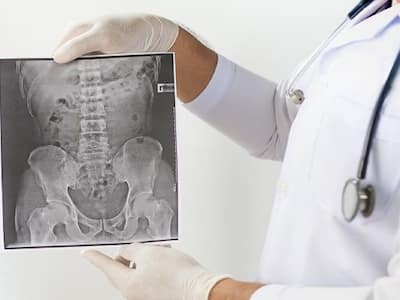VERIFIED

Painkillers and non-steroidal anti-inflammatory drugs (NSAIDs) help ease the pain and reduce inflammation.
What is ankylosing spondylitis (AS)? The condition may also affect the eyes, lungs, heart, hips, and ankles. Inflammation at the attachment of ligaments and tendons to the bone is a peculiar feature of this condition. Who is at risk for AS? Explains Dr Siddharth M. Shah, Consultant- Joint Replacement and Orthopedics Surgeon, S. L. Raheja Hospital, Mahim A Fortis Associate.
Is There An Age Or Gender Predisposition?
Individuals with the HLA-B27 gene have an increased risk of AS. However, only some people carrying this gene will suffer from the disease. People between 20 and 40 are usually affected by AS. Although it was previously thought to affect males predominantly, recent data does not indicate gender preponderance.
What Are The Symptoms Of Ankylosing Spondylitis?
Low back pain and stiffness lasting three months or longer is one of the most common presentations of AS. The symptoms typically worsen in the morning and improve as the day passes. Those suffering from AS may also complain of heel pain, hip pain and stiffness, ankle pain and swelling, or redness of eyes with blurring of vision. As the disease progresses, the vertebrae may fuse, resulting in a stiff spine with a hunched back deformity.
How Is Ankylosing Spondylitis Diagnosed?
AS is diagnosed based on clinical symptoms and signs. Based on your history, the doctor will check for spine stiffness, hips or restricted chest movements. The presence of the HLA-B27 gene detects the severity of inflammation in the body. X-rays or MRIs may be advised to see inflammation or damage in the spine or pelvic joints.
Is There A Cure For AS? How Is AS Treated?
AS has no cure for disease progression. AS requires multi-modal treatment. Physiotherapy and exercises play a vital role as they help to maintain flexibility and strength of the spine and affected joints. Painkillers and non-steroidal anti-inflammatory drugs (NSAIDs) help ease the pain and reduce inflammation. Steroids and a particular class of medicines called disease-modifying anti-rheumatic drugs (DMARDs) may be advised to control and prevent the progression of AS. In severe cases of AS or those not responding to other treatments, biological agents like anti-TNF alpha may be indicated for controlling the disease.
When Is Surgery Required?
Advanced or longstanding AS can result in a fused spine or hips, which may require surgical treatment. A timely diagnosis of AS and appropriate treatment are critical for controlling the disease and preventing deformity and disability. Adherence to professional advice and regular follow-up can ensure effective treatment.
Post source: The Health Site




